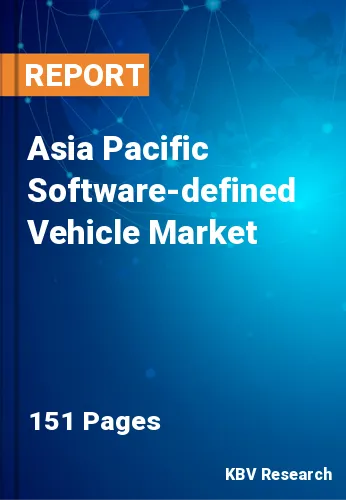Chapter 1. Market Scope & Methodology
1.1 Market Definition
1.2 Objectives
1.3 Market Scope
1.4 Segmentation
1.4.1 Asia Pacific Software-defined Vehicle Market, by Offering
1.4.2 Asia Pacific Software-defined Vehicle Market, by Application
1.4.3 Asia Pacific Software-defined Vehicle Market, by Vehicle Type
1.4.4 Asia Pacific Software-defined Vehicle Market, by Country
1.5 Methodology for the research
Chapter 2. Market at a Glance
2.1 Key Highlights
Chapter 3. Market Overview
3.1 Introduction
3.1.1 Overview
3.1.1.1 Market Composition and Scenario
3.2 Key Factors Impacting the Market
3.2.1 Market Drivers
3.2.2 Market Restraints
Chapter 4. Competition Analysis - Global
4.1 KBV Cardinal Matrix
4.2 Recent Industry Wide Strategic Developments
4.2.1 Partnerships, Collaborations and Agreements
4.2.2 Acquisition and Mergers
4.3 Market Share Analysis, 2022
4.4 Top Winning Strategies
4.4.1 Key Leading Strategies: Percentage Distribution (2019-2023)
4.4.2 Key Strategic Move: (Partnerships, Collaborations & Agreements: 2020, Apr – 2023, Sep) Leading Players
4.5 Porter’s Five Forces Analysis
Chapter 5. Asia Pacific Software-defined Vehicle Market, by Offering
5.1 Asia Pacific Hardware Market, by Country
5.2 Asia Pacific Software Market, by Country
5.3 Asia Pacific Services Market, by Country
Chapter 6. Asia Pacific Software-defined Vehicle Market, by Application
6.1 Asia Pacific ADAS/HAD Market, by Country
6.2 Asia Pacific Powertrain & Chassis Market, by Country
6.3 Asia Pacific Infotainment Market, by Country
6.4 Asia Pacific Connectivity & Security Market, by Country
6.5 Asia Pacific Body & Energy Market, by Country
Chapter 7. Asia Pacific Software-defined Vehicle Market, by Vehicle Type
7.1 Asia Pacific ICE Market, by Country
7.2 Asia Pacific BEV Market, by Country
7.3 Asia Pacific HEV/PHEV Market, by Country
Chapter 8. Asia Pacific Software-defined Vehicle Market, by Country
8.1 China Software-defined Vehicle Market
8.1.1 China Software-defined Vehicle Market, by Offering
8.1.2 China Software-defined Vehicle Market, by Application
8.1.3 China Software-defined Vehicle Market, by Vehicle Type
8.2 Japan Software-defined Vehicle Market
8.2.1 Japan Software-defined Vehicle Market, by Offering
8.2.2 Japan Software-defined Vehicle Market, by Application
8.2.3 Japan Software-defined Vehicle Market, by Vehicle Type
8.3 India Software-defined Vehicle Market
8.3.1 India Software-defined Vehicle Market, by Offering
8.3.2 India Software-defined Vehicle Market, by Application
8.3.3 India Software-defined Vehicle Market, by Vehicle Type
8.4 South Korea Software-defined Vehicle Market
8.4.1 South Korea Software-defined Vehicle Market, by Offering
8.4.2 South Korea Software-defined Vehicle Market, by Application
8.4.3 South Korea Software-defined Vehicle Market, by Vehicle Type
8.5 Singapore Software-defined Vehicle Market
8.5.1 Singapore Software-defined Vehicle Market, by Offering
8.5.2 Singapore Software-defined Vehicle Market, by Application
8.5.3 Singapore Software-defined Vehicle Market, by Vehicle Type
8.6 Malaysia Software-defined Vehicle Market
8.6.1 Malaysia Software-defined Vehicle Market, by Offering
8.6.2 Malaysia Software-defined Vehicle Market, by Application
8.6.3 Malaysia Software-defined Vehicle Market, by Vehicle Type
8.7 Rest of Asia Pacific Software-defined Vehicle Market
8.7.1 Rest of Asia Pacific Software-defined Vehicle Market, by Offering
8.7.2 Rest of Asia Pacific Software-defined Vehicle Market, by Application
8.7.3 Rest of Asia Pacific Software-defined Vehicle Market, by Vehicle Type
Chapter 9. Company Profiles
9.1 Robert Bosch GmbH
9.1.1 Company Overview
9.1.2 Financial Analysis
9.1.3 Segmental and Regional Analysis
9.1.4 Research & Development Expense
9.1.5 Recent strategies and developments:
9.1.5.1 Partnerships, Collaborations, and Agreements:
9.1.6 SWOT Analysis
9.2 Continental AG
9.2.1 Company Overview
9.2.2 Financial Analysis
9.2.3 Segmental and Regional Analysis
9.2.4 Research & Development Expense
9.2.5 Recent strategies and developments:
9.2.5.1 Partnerships, Collaborations, and Agreements:
9.2.5.2 Acquisition and Mergers:
9.2.6 SWOT Analysis
9.3 Valeo SA
9.3.1 Company Overview
9.3.2 Financial Analysis
9.3.3 Segmental and Regional Analysis
9.3.4 Research & Development Expense
9.3.5 Recent strategies and developments:
9.3.5.1 Partnerships, Collaborations, and Agreements:
9.3.6 SWOT Analysis
9.4 Aptiv PLC
9.4.1 Company Overview
9.4.2 Financial Analysis
9.4.3 Segmental and Regional Analysis
9.4.4 Research & Development Expense
9.4.5 Recent strategies and developments:
9.4.5.1 Partnerships, Collaborations, and Agreements:
9.4.5.2 Acquisition and Mergers:
9.4.6 SWOT Analysis
9.5 Marelli Holdings Co., Ltd.
9.5.1 Company Overview
9.5.2 Recent strategies and developments:
9.5.2.1 Partnerships, Collaborations, and Agreements:
9.5.3 SWOT Analysis
9.6 Tesla, Inc.
9.6.1 Company Overview
9.6.2 Financial Analysis
9.6.3 Segmental and Regional Analysis
9.6.4 Research & Development Expense
9.6.5 SWOT Analysis
9.7 NVIDIA Corporation
9.7.1 Company Overview
9.7.2 Financial Analysis
9.7.3 Segmental and Regional Analysis
9.7.4 Research & Development Expenses
9.7.5 Recent strategies and developments:
9.7.5.1 Partnerships, Collaborations, and Agreements:
9.7.6 SWOT Analysis
9.8 Volkswagen AG
9.8.1 Company Overview
9.8.2 Financial Analysis
9.8.3 Segmental and Regional Analysis
9.8.4 Research & Development Expense
9.8.5 SWOT Analysis
9.9 HARMAN International Industries, Inc (Samsung Electronics Co., Ltd.)
9.9.1 Company Overview
9.9.2 Financial Analysis
9.9.3 Segmental and Regional Analysis
9.9.4 Research & Development Expenses
9.9.5 Recent strategies and developments:
9.9.5.1 Partnerships, Collaborations, and Agreements:
9.9.5.2 Acquisition and Mergers:
9.9.6 SWOT Analysis
9.10. BlackBerry Limited
9.10.1 Company Overview
9.10.2 Financial Analysis
9.10.3 Segmental and Regional Analysis
9.10.4 Research & Development Expenses
9.10.5 Recent strategies and developments:
9.10.5.1 Partnerships, Collaborations, and Agreements:
9.10.6 SWOT Analysis

